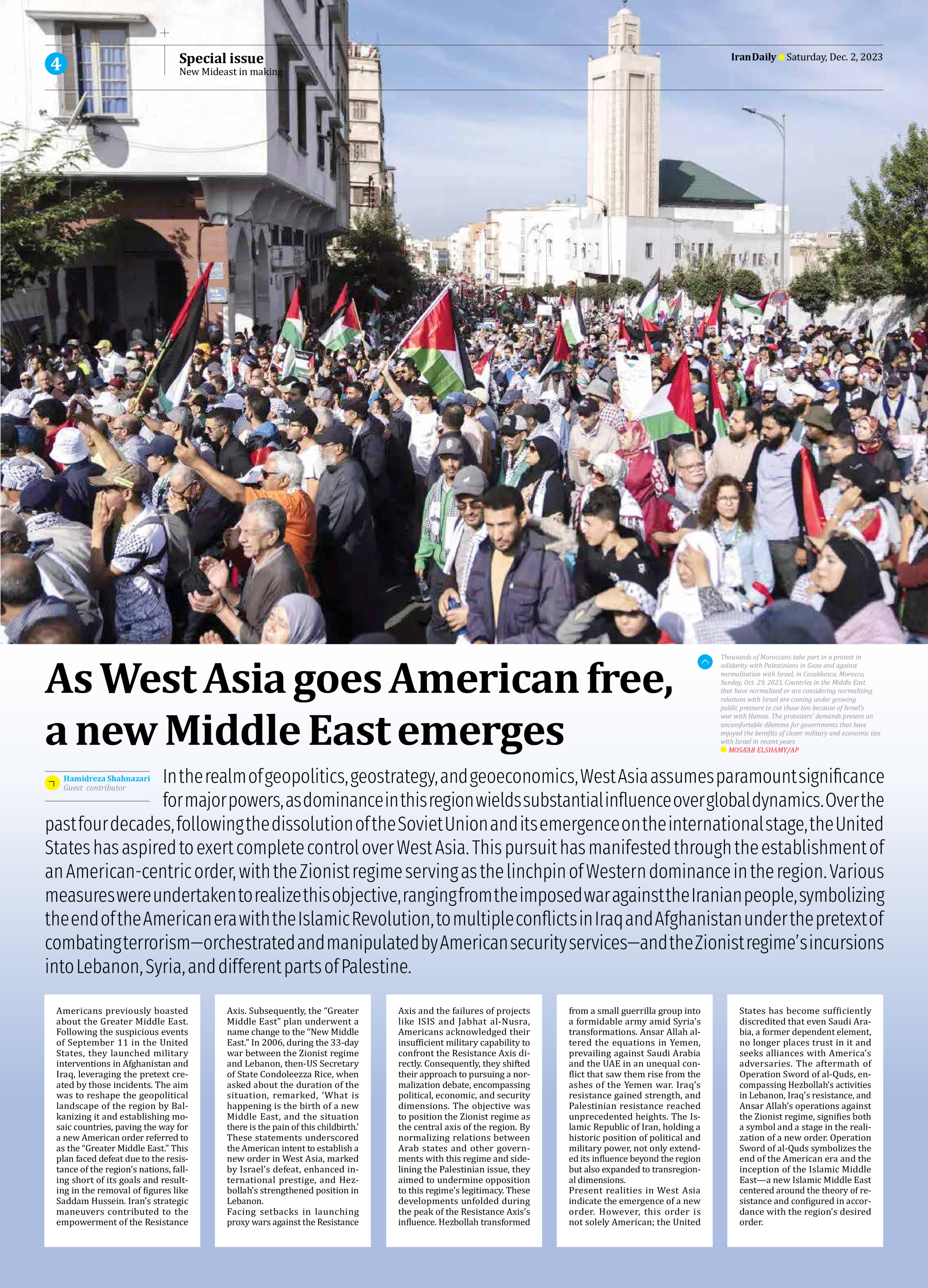
As West Asia goes American free, a new Middle East emerges
Hamidreza Shahnazari
Guest contributor
In the realm of geopolitics, geostrategy, and geoeconomics, West Asia assumes paramount significance for major powers, as dominance in this region wields substantial influence over global dynamics. Over the past four decades, following the dissolution of the Soviet Union and its emergence on the international stage, the United States has aspired to exert complete control over West Asia. This pursuit has manifested through the establishment of an American-centric order, with the Zionist regime serving as the linchpin of Western dominance in the region. Various measures were undertaken to realize this objective, ranging from the imposed war against the Iranian people, symbolizing the end of the American era with the Islamic Revolution, to multiple conflicts in Iraq and Afghanistan under the pretext of combating terrorism—orchestrated and manipulated by American security services—and the Zionist regime’s incursions into Lebanon, Syria, and different parts of Palestine.
Americans previously boasted about the Greater Middle East. Following the suspicious events of September 11 in the United States, they launched military interventions in Afghanistan and Iraq, leveraging the pretext created by those incidents. The aim was to reshape the geopolitical landscape of the region by Balkanizing it and establishing mosaic countries, paving the way for a new American order referred to as the “Greater Middle East.” This plan faced defeat due to the resistance of the region’s nations, falling short of its goals and resulting in the removal of figures like Saddam Hussein. Iran’s strategic maneuvers contributed to the empowerment of the Resistance Axis. Subsequently, the “Greater Middle East” plan underwent a name change to the “New Middle East.” In 2006, during the 33-day war between the Zionist regime and Lebanon, then-US Secretary of State Condoleezza Rice, when asked about the duration of the situation, remarked, ‘What is happening is the birth of a new Middle East, and the situation there is the pain of this childbirth.’ These statements underscored the American intent to establish a new order in West Asia, marked by Israel’s defeat, enhanced international prestige, and Hezbollah’s strengthened position in Lebanon.
Facing setbacks in launching proxy wars against the Resistance Axis and the failures of projects like ISIS and Jabhat al-Nusra, Americans acknowledged their insufficient military capability to confront the Resistance Axis directly. Consequently, they shifted their approach to pursuing a normalization debate, encompassing political, economic, and security dimensions. The objective was to position the Zionist regime as the central axis of the region. By normalizing relations between Arab states and other governments with this regime and sidelining the Palestinian issue, they aimed to undermine opposition to this regime’s legitimacy. These developments unfolded during the peak of the Resistance Axis’s influence. Hezbollah transformed from a small guerrilla group into a formidable army amid Syria’s transformations. Ansar Allah altered the equations in Yemen, prevailing against Saudi Arabia and the UAE in an unequal conflict that saw them rise from the ashes of the Yemen war. Iraq’s resistance gained strength, and Palestinian resistance reached unprecedented heights. The Islamic Republic of Iran, holding a historic position of political and military power, not only extended its influence beyond the region but also expanded to transregional dimensions.
Present realities in West Asia indicate the emergence of a new order. However, this order is not solely American; the United States has become sufficiently discredited that even Saudi Arabia, a former dependent element, no longer places trust in it and seeks alliances with America’s adversaries. The aftermath of Operation Sword of al-Quds, encompassing Hezbollah’s activities in Lebanon, Iraq’s resistance, and Ansar Allah’s operations against the Zionist regime, signifies both a symbol and a stage in the realization of a new order. Operation Sword of al-Quds symbolizes the end of the American era and the inception of the Islamic Middle East—a new Islamic Middle East centered around the theory of resistance and configured in accordance with the region’s desired order.







